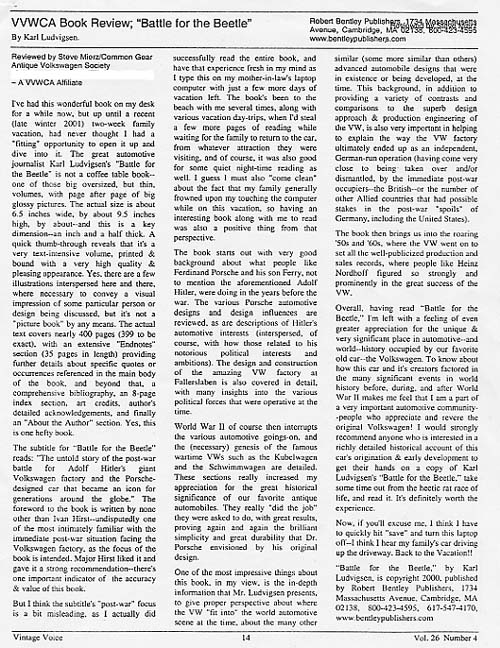|
|
Battle for the Beetle
Price: $64.95
|
Vintage Voice - Vol. 26, No. 4 - April 2001
VVWCA Book Review; "Battle for the Beetle"
I've had this wonderful book on my desk for a while now, but up until a recent (late winter 2001) two-week family vacation, had never thought I had a "fitting" opportunity to open it up and dive into it. The great automotive journalist Karl Ludvigsen's "Battle for the Beetle" is not a coffee table book--one of those big oversized, but thin, volumes, with page after page of big glossy pictures. The actual size is about 6.5 inches wide, by about 9.5 inches high, by about--and this is a key dimension--an inch and a half thick. A quick thumb-through reveals that it's a very text-intensive volume, printed & bound with a very high quality & pleasing appearance. Yes, there are a few illustrations interspersed here and there, where necessary to convey a visual impression of some particular person or design being discussed, but it's not a "picture book" by any means. The actual text covers nearly 400 pages (399 to be exact), with an extensive "Endnotes" section (35 pages in length) providing further details about specific quotes or occurrences referenced in the main body of the book, and beyond that, a comprehensive bibliography, an 8-page index section, art credits, author's detailed acknowledgements, and finally an "About the Author" section. Yes, this is one hefty book.
The subtitle for "Battle for the Beetle" reads: "The untold story of the post-war battle for Adolf Hitler's giant Volkswagen factory and the Porsche-designed car that became an icon for generations around the globe." The foreword to the book is written by none other than Ivan Hirst--undisputedly one of the most intimately familiar with the immediate post-war situation facing the Volkswagen factory, as the focus of the book is intended. Major Hirst liked it and gave it a strong recommendation--there's one important indicator of the accuracy & value of this book.
But I think the subtitle's "post-war" focus is a bit misleading, as I actually did successfully read the entire book, and have that experience fresh in my mind as I type this on my mother-in-law's laptop computer with just a few more days of vacation left. The book's been to the beach with me several times, along with various vacation day-trips, when I'd steal a few more pages of reading while waiting for the family to return to the car, from whatever attraction they were visiting, and of course, it was also good for some quiet night-time reading as well. I guess I must also "come clean" about the fact that my family generally frowned upon my touching the computer while on this vacation, so having an interesting book along with me to read was also a positive thing from that perspective.
The book starts out with very good background about what people like Ferdinand Porsche and his son Ferry, not to mention the aforementioned Adolf Hitler, were doing in the years before the war. The various Porsche automotive designs and design influences are reviewed, as are descriptions of Hitler's automotive interests (interspersed, of course, with how those related to his notorious political interests and ambitions). The design and construction of the amazing VW factory at Fallerslaben is also covered in detail, with many insights into the various political forces that were operative at the time.
World War II of course then interrupts the various automotive goings-on, and the (necessary) genesis of the famous wartime VW's such as the Kubelwagen and the Schwimmwagen are detailed. These sections really increased my appreciation for the great historical significance of our favorite antique automobiles. They really "did the job" they were asked to do, with great results, proving again and again the brilliant simplicity and great durability that Dr. Porsche envisioned by his original design.
One of the most impressive things about this book, in my view, is the in-depth information that Mr. Ludvigsen presents, to give proper perspective about where the VW "fit into" the world automotive scene at the time, about the many other similar (some more similar than others) advanced automobile designs that were in existence or being developed, at the time. This background, in addition to providing a variety of contrasts and comparisons to the superb design approach & production engineering of the VW, is also very important in helping to explain the way the VW factory ultimately ended up as an independent, German-run operation (having come very close to being taken over and/or dismantled, by the immediate post-war occupiers--the British--or the number of other Allied countries that had possible stakes in the post-war "spoils" of Germany, including the United States).
The book then brings us into the roaring '50s and '60s, where the VW went on to set all the well-publicized production and sales records, where people like Heinz Nordhoff figured so strongly and prominently in the great success of the VW.
Overall, having read "Battle for the Beetle", I'm left with a feeling of even greater appreciation for the unique & very significant place in automotive--and world--history occupied by our favorite old car--the Volkswagen. To know about how this car and it's creators factored in the many significant events in world history before, during, and after World War II makes me feel that I am a part of a very important automotive community--people who appreciate and revere the original Volkswagen! I would strongly recommend anyone who is interested in a richly detailed historical account of this car's origination & early development to get their hands on a copy of Karl Ludvigsen's "Battle for the Beetle," take some time out from the hectic rat race of life, and read it. It's definitely worth the experience.

Article from and courtesy of Vintage Voice, the Vintage Volkswagen Club of America newsletter - April 2001
![[B] Bentley Publishers](http://assets1.bentleypublishers.com/images/bentley-logos/bp-banner-234x60-bookblue.jpg)

